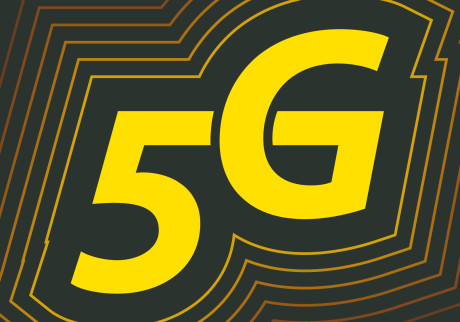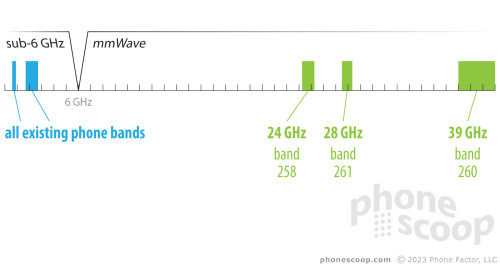What is 5G? The Basics
May 3, 2019, 10:36 AM by Rich Brome @rbrome.bsky.social

If you follow tech at all, you've probably been hearing about 5G for a while. If you've managed to avoid the 5G hype so far, brace yourself; the 5G hype machine is just warming up. So what is 5G? Should you care? How does it work? This the first in a series of articles that break down the ins and outs of 5G.
What It Is
5G is a new radio standard for mobile phone networks. Technically, it's called "NR", which stands for "New Radio". (So creative, those standards people!) Because it's a new standard, it requires new hardware, both on the network side, and on the consumer side. In other words, you'll need a new phone to actually use 5G NR yourself.
The main benefits are faster data and greater network capacity. The data is faster in two ways: throughput and latency. Throughput is what you probably associate with data speed. Latency means the delay between your request for data and when the first bit of data comes back; it's the round-trip time. This is important for things like gaming, but also helps everything feel a little faster and more responsive.
Greater network capacity is a fuzzier concept. If you've experienced a slower network during peak times like rush hour or lunchtime, that's a capacity issue. 5G will help with that. But also, as more people use more data on their phones — an unrelenting trend — greater network capacity is needed simply to keep everything from grinding to a halt. And as unsexy as it sounds, that might be the most important benefit. While 5G will make things better, it would be necessary even if all the industry wanted to do was maintain the status quo.
What It Isn't
If you already see a "5Ge" icon on your phone, that means you have 5G, right? NO! That is, quite plainly, an elaborate lie from AT&T to mislead their own customers into thinking AT&T has some kind of lead in 5G. That is simply not the case. AT&T's "5Ge" is exactly the same technology that their competitors offer and correctly call 4G.
If you've heard that some existing phones secretly have 5G inside waiting to be enabled, that's simply not true. This annoyingly persistent rumor is no more than a misreading of extraneous text buried in complex software. It's wishful thinking. No, your existing 4G phone will never support actual 5G; not even the latest flagships like the iPhone XS and Galaxy S10. I promise.
The Transition
The transition to 5G NR is going to be a lot like previous technology transitions. We've been through this all before, with 4G LTE, and before that with 3G.
As before, there will be a very long (almost a decade) period where both the old and new technologies are in use, ensuring a seamless transition. Both 4G and 5G networks will be available simultaneously. Phones will support both 4G and 5G, and automatically use the best network available at the moment (or even both).
5G will be available first in very high-end phones, filtering down to more affordable phones over a period several years.
The Two Flavors of 5G
One of the big new features of 5G is support for mmWave frequency bands. These are entirely new radio bands that operate at way higher frequencies compared to the the bands that mobile phones have used until now.

In order to distinguish traditional mobile phone frequency bands from mmWave, the industry coined a new term: "sub-6 GHz". When you see "sub-6 GHz" or just "sub-6", that just means all of the radio frequency bands that your phone uses today.
5G will be deployed in sub-6 GHz bands, alongside 4G LTE, where it will provide incremental improvements in speed. It won't blow your mind, but it should be faster. Crucially, sub-6 5G will eventually offer the same coverage you're used to with 4G LTE today.
5G in mmWave is very different. The radio frequencies involved are so high that they have very different characteristics. The range of a mmWave "tower" is more like that of a Wi-Fi hotspot: measured in feet instead of miles. The frequencies are much higher than Wi-Fi, though, so not only does it have trouble penetrating walls, it doesn't even go through glass well.
5G in sub-6 can use the same antennas as 4G, since the frequency bands are, in fact, the same. But mmWave requires new antennas. On the phone end, it requires a whole new type of antenna that resembles a postage stamp. It takes up extra room inside the phone, which is one of the reasons 5G phones — at least ones that support mmWave — will tend to be on the large side.
How mmWave Helps Everyone
It's simply impossible to provide mmWave coverage nationwide. But that's fine, because it is possible to cover the dense core areas of major cities with mmWave networks, and that's where existing networks are most congested.
Sure, you might only get a mmWave signal while you walk down the sidewalk downtown, but the key is that you've freed up some capacity on the sub-6 network to provide better service to nearby people indoors. And vice-versa: you'll get better service inside your downtown office building. Not because you're using mmWave, but because the people outside are using mmWave (freeing up some capacity on the sub-6 network for you).
These effects will help everyone using sub-6 networks, both 4G and 5G. That means you might even see a little better performance on the 4G network, with your 4G phone, if you're within the coverage of a mmWave 5G network and enough people are using it (instead of the sub-6 4G network you're on.)
How 5G Strategies Differ
It's important to keep those frequency band differences in mind as the first 5G networks roll out, because each company is doing it differently. AT&T and Verizon are rolling out 5G first, but they're only rolling it out in mmWave bands to begin with. The coverage of these networks will be very limited, but it's important to understand that the issue here is not the 5G technology, but rather the mmWave bands.
AT&T has promised to add sub-6 bands to its 5G network by the end of 2019, which will dramatically improve 5G coverage. Verizon will presumably roll out sub-6 5G at some point, although they have yet to announce it.
Sprint and T-Mobile, meanwhile, are starting with sub-6 bands for their initial 5G deployments. This should provide good 5G coverage.
Baby Steps
5G is not an all-or-nothing affair. The first 5G networks are actually quite limited in a number of ways, as are the first 5G phones. Throughout 2019 and 2020, additional key parts of the 5G puzzle will fall into place, and it will continue to evolve in subsequent years.
5G promises to deliver blazing speeds and low latency. But real-world tests of the first 5G networks show that it doesn't live up to the hype just yet. There are a few reasons for this, but one is that some really key features of 5G have not been implemented yet. All we have so far is the bare minimum to be considered working 5G. We won't see the full potential of 5G until networks are upgraded over the coming months with important features like upload capability, wider bandwidth, beam-forming, and massive MIMO.
Even more important are the limitations of the first 5G phones, like the Samsung Galaxy S10 5G and LG V50. They aren't capable of accessing most sub-6 5G networks; the only US 5G networks they can access are mmWave and Sprint's band 41. So when 2020 comes around and you want to use the new sub-6 5G coverage offered by AT&T and T-Mobile, these first phones won't be able to access it. There are other technical limitations of the first 5G phones, but that's the most crucial.
5G is a big deal for the industry, but how important is it to you as a consumer? When should you think about getting a 5G phone? We go into that in the second part of our series on 5G: 10 Reasons You Can Ignore 5G.


 Qualcomm vs. Bullitt: Satellite Connectivity Comparison and Hands On
Qualcomm vs. Bullitt: Satellite Connectivity Comparison and Hands On
 Hands On with the moto g stylus 5G (2023)
Hands On with the moto g stylus 5G (2023)
 iPhone 15 Series Goes All-In on USB-C and Dynamic Island
iPhone 15 Series Goes All-In on USB-C and Dynamic Island
 Apple Watch Series 9 Detects Finger Gestures, Brings Siri On-Device
Apple Watch Series 9 Detects Finger Gestures, Brings Siri On-Device
 Google Pixel 8 Series Saves the Best for the Pro
Google Pixel 8 Series Saves the Best for the Pro


